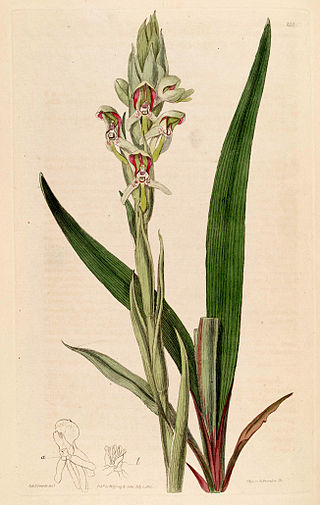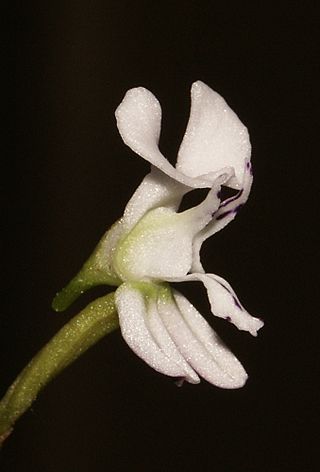
The horned screamer is a member of a small family of birds, the Anhimidae, which occurs in wetlands of tropical South America. There are three screamer species, the other two being the southern screamer and the northern screamer in the genus Chauna. They are related to the ducks, geese and swans, which are in the family Anatidae, but have bills looking more like those of game birds.

Disa is a genus of flowering plants in the family Orchidaceae. It comprises about 182 species. Most of the species are indigenous to tropical and southern Africa, with a few more in the Arabian Peninsula, Madagascar, and Réunion. Disa bracteata is naturalised in Western Australia, where the local name is "African weed-orchid."

Corylus cornuta, the beaked hazelnut, is a deciduous shrubby hazel with two subspecies found throughout most of North America.

Prosopis juliflora is a shrub or small tree in the family Fabaceae, a kind of mesquite. It is native to Mexico, South America and the Caribbean. It has become established as an invasive weed in Africa, Asia, Australia and elsewhere. It is a contributing factor to continuing transmission of malaria, especially during dry periods when sugar sources from native plants are largely unavailable to mosquitoes.

Dennstaedtia is a mostly tropical and subtropical genus of ferns described as a genus in 1801. hayscented fern, or cup ferns, are common names for some species in this genus. It includes 58 species native to the tropical Americas, Madagascar, southern and eastern Asia, Australia, New Guinea, and the Pacific Islands.

Disa bracteata, also known as the bract disa, leek orchid or the South African weed orchid is a species of orchid native to South Africa.

Disa cardinalis is a species of orchid found in South Africa.

Disa cernua is a species of orchid found in South Africa, in Eastern Cape and Western Cape provinces.

Disa draconis is a species of orchid found in South Africa.

Disa purpurascens is a species of orchid found in South Africa. It is also known as the early blue disa or the bloumoederkappie.

Disa sagittalis is a species of orchid found in South Africa from south and southeast Cape Province to southern KwaZulu-Natal.

Disa tripetaloides is a species of orchid that grows along the edges of streams in South Africa. This is one of the smaller species in the genus Disa in the section Disa. There are populations that come from the winter-rainfall areas of South Africa, and summer-rainfall areas of South Africa.
Disa borbonica is a species of orchid in the Orchidaceae family. It is endemic to Réunion.

Disa graminifolia is a species of orchid found in the Cape Floristic Region of South Africa.

Disa ferruginea is a sturdy, reed-like terrestrial plant that typically grows between 200 and 450 mm tall. It has linear radical leaves that develop after flowering, while the dry cauline leaves form sheaths. The inflorescence is dense, with 1 to 40 flowers. The flowers themselves are bright red to orange, often with some yellow components. The median sepal has an apiculate tip, and a galea is 8 to 10 mm deep. The slender spur of the flower grades into the galea and measures 7 to 20 mm long. The lateral sepals project outward and are elliptic to narrowly elliptic, with apiculi that can reach up to 4 mm in length. The petals are spear-shaped and 5 to 7 mm long, while the lip is narrowly egg- to spear-shaped and 10 to 12 mm long.

Disa aurata is a species of orchid found in Swellendam area of Cape Province, South Africa at elevations of 0 – 1000 meters.

Disa virginalis is a species of orchid found in Southwest Cape Province, South Africa.
Disa zombica is a species of orchid, native to eastern and southern Tropical Africa. Its roots are edible and are made into a delicacy called chinaka in Malawi.
Disa intermedia is a species of orchid, native to Eswatini, formally Swaziland.
















